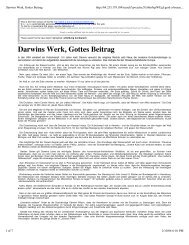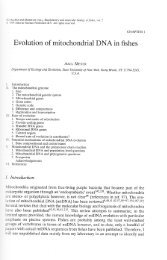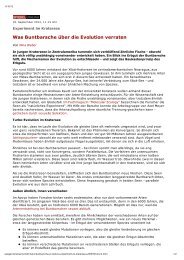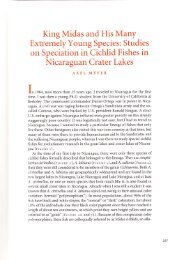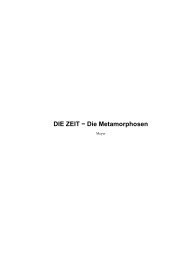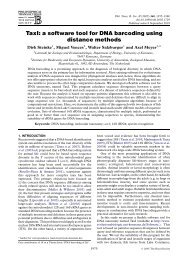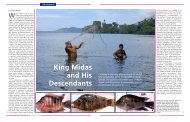'Living Fossil' Fish Is Dethroned -- Roush 277 ... - Meyer Lab home
'Living Fossil' Fish Is Dethroned -- Roush 277 ... - Meyer Lab home
'Living Fossil' Fish Is Dethroned -- Roush 277 ... - Meyer Lab home
Create successful ePaper yourself
Turn your PDF publications into a flip-book with our unique Google optimized e-Paper software.
EVOLUTION: <strong>'Living</strong> <strong>Fossil'</strong> <strong>Fish</strong> <strong>Is</strong> <strong>Dethroned</strong> -- <strong>Roush</strong> <strong>277</strong> (5331... http://www.sciencemag.org/cgi/content/full/<strong>277</strong>/5331/1436<br />
> <strong>Roush</strong> , pp. 1436<br />
Science 5 September 1997:<br />
Vol. <strong>277</strong>. no. 5331, p. 1436<br />
DOI: 10.1126/science.<strong>277</strong>.5331.1436<br />
RESEARCH NEWS<br />
EVOLUTION:<br />
<strong>'Living</strong> <strong>Fossil'</strong> <strong>Fish</strong> <strong>Is</strong> <strong>Dethroned</strong><br />
Wade <strong>Roush</strong><br />
Current <strong>Is</strong>sue Previous <strong>Is</strong>sues Science Express Science Products My Science<br />
About the Journal<br />
About 370 million years ago, a restless faction of the fishes traded in their<br />
fins for feet and set out to colonize land. Biologists have debated for decades<br />
exactly which members of the fish family made this bold move--and<br />
therefore which of their descendants are our closest living gilled relatives.<br />
Now it seems that the popular favorite, the "living fossil" known as the<br />
coelacanth, is out of the running.<br />
That's the tentative conclusion reached by two researchers who have<br />
completed the most comprehensive survey to date of coelacanth<br />
mitochondrial DNA (mtDNA). Mitochondria, organelles that serve as power<br />
plants in all higher cells, carry their own small complement of genes that<br />
mutates over evolutionary time, enabling scientists to infer how long any two<br />
species have been diverging by comparing their mtDNA. In this month's issue<br />
of the German journal Naturwissenschaften, geneticists Axel <strong>Meyer</strong> of the<br />
University of Konstanz in Germany and Rafael Zardoya of the Museo Nacional<br />
de Ciencias Naturales in Madrid, Spain, report that the mtDNA of<br />
lungfish--an ancient class of air-breathing fish found in Africa, Australia,<br />
and South America--is closer than that of the coelacanth to the mtDNA of<br />
land animals such as frogs.<br />
That's "an interesting piece of information," says S. Blair Hedges, an<br />
evolutionary biologist at Pennsylvania State University in University Park. He<br />
explains that knowing which extant fish is closest to the first terrestrial<br />
tetrapods, or four-legged creatures, might tell biologists which key<br />
anatomical innovations enabled our fishlike ancestors to conquer the land. "It<br />
helps reconstruct what the organisms looked like at that time, and maybe<br />
what environmental factors may have been involved," says Hedges, who<br />
published a study in 1993--based on several mtDNA sequences--that also<br />
pointed toward the lungfish.<br />
Paleontologists of the 19th and early 20th centuries knew coelacanths only<br />
Home > Science Magazine > 5 September 1997<br />
ADVERTISEMENT<br />
ADVERTISEMENT<br />
1 of 3 4/24/06 5:56 PM
EVOLUTION: <strong>'Living</strong> <strong>Fossil'</strong> <strong>Fish</strong> <strong>Is</strong> <strong>Dethroned</strong> -- <strong>Roush</strong> <strong>277</strong> (5331... http://www.sciencemag.org/cgi/content/full/<strong>277</strong>/5331/1436<br />
from the fossil record, but that was enough to convince them that the<br />
unattractive creatures, with lobed fins that resemble primitive tetrapod limbs,<br />
were close relatives of the first land animals. Then, in 1938, anglers off the<br />
Comoro <strong>Is</strong>lands in the Indian Ocean stunned the scientific world by catching a<br />
live coelacanth, the first of many. The discovery caused such a sensation, says<br />
<strong>Meyer</strong>, that the coelacanth-tetrapod connection "is still the predominant<br />
textbook dogma. It has to do to some degree with the romance of it."<br />
In the 1980s, paleontologists began finding hints that the dogma might be<br />
wrong. For one thing, features of fossil and living lungfish such as their<br />
external nasal openings--important for any animal that needs to breathe and<br />
chew at the same time--pointed to lungfish, not coelacanths, as the closest<br />
sister group to the tetrapods. At the same time, molecular biologists such as<br />
the late Allan Wilson at the University of California, Berkeley, had begun to<br />
examine the evolutionary relationships of species by comparing similar<br />
fragments of their mitochondrial genes, which are often simpler and easier to<br />
analyze than nuclear genes. That allowed Wilson and <strong>Meyer</strong> to announce in a<br />
1990 paper that tetrapods arose from the branch of the evolutionary tree<br />
leading to the lungfish, not the coelacanth. Later, Hedges and two colleagues<br />
reported similar findings.<br />
As researchers sequenced more coelacanth mtDNA, however, the creature<br />
edged back into contention. In the July issue of Genetics, for example, <strong>Meyer</strong><br />
and Zardoya reported that a statistical comparison using the complete<br />
coelacanth mtDNA sequence didn't point unambiguously to either lungfish or<br />
coelacanths as the tetrapods' closest sister group. As Hedges points out,<br />
however, mtDNA may mutate at different rates in different lineages,<br />
sometimes resulting in phylogenetic trees that contain "highly significant but<br />
wrong" groupings. Indeed, when <strong>Meyer</strong> and Zardoya reanalyzed their data for<br />
their latest study, they concluded that they could "clearly reject" the<br />
possibility that coelacanths are the closest sister group to tetrapods. (The<br />
possibility that coelacanths and lungfish are equally close relations of<br />
tetrapods, although unlikely, could not be formally ruled out.)<br />
That means that traits seen in the lungfish, such as external nostrils and<br />
modifications in the circulatory system and blood chemistry, may well provide<br />
the best clues to what the earliest land animals looked like. But to settle the<br />
issue once and for all, says <strong>Meyer</strong>, biologists will need to examine the more<br />
complex nuclear genes of coelacanths and lungfish. "It's an important<br />
question," <strong>Meyer</strong> says, "and of course I would like to be the one to answer it."<br />
Magazine | News | STKE | SAGE KE | Careers | Collections | Help | Site Map<br />
To Advertise Find Products<br />
ADVERTISEMENT<br />
FEATURED JOBS<br />
Department<br />
Head/Distinguished Chaired<br />
Professorship<br />
University of Texas, Dallas<br />
Richardson, TX<br />
BS/MS Research Associate -<br />
Inflammatory Disease<br />
Modeling - Job I.D.15347BR<br />
Schering-Plough Research<br />
Institute<br />
Kenilworth, NJ<br />
FULL-TIME NEUROIMAGING<br />
RESEARCH POSITION FOR<br />
PHYSICIANS<br />
NIH/NIMH (National Institute<br />
of Mental Health)<br />
Bethesda, MD<br />
BS/MS Research Associate<br />
-Obesity/Metabolic Disease -<br />
Bio. Research - Job I.D.<br />
15242BR<br />
Schering-Plough Research<br />
Institute<br />
Kenilworth, NJ<br />
Entomologist<br />
Athenix Corp.<br />
Research Triangle Park, NC<br />
POSTDOCTORAL POSITION<br />
Indiana University<br />
Indianapolis, IN<br />
ASSISTANT PROFESSOR<br />
Oklahoma State University<br />
Oklahoma<br />
More jobs<br />
2 of 3 4/24/06 5:56 PM
EVOLUTION: <strong>'Living</strong> <strong>Fossil'</strong> <strong>Fish</strong> <strong>Is</strong> <strong>Dethroned</strong> -- <strong>Roush</strong> <strong>277</strong> (5331... http://www.sciencemag.org/cgi/content/full/<strong>277</strong>/5331/1436<br />
Subscribe | Feedback | Privacy / Legal | About Us | Advertise With Us | Contact Us<br />
© 1997 American Association for the Advancement of Science. All Rights Reserved.<br />
3 of 3 4/24/06 5:56 PM



